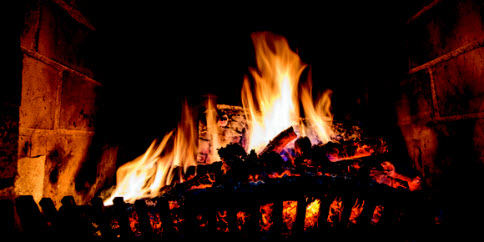While fireplaces provide coziness and style to a home, they also have the capacity to destroy it if not tended properly.
Richard Dale, a home safety expert with Home Depot, offers the following advice to ensure your fireplace works safely and efficiently:
• Never use your fireplace until it’s thoroughly tested. To avoid the chance of a chimney fire, have your chimney inspected by a professional each year and cleaned after burning approximately one cord of wood. Regular fireplace use can cause creosote build-up in the chimney, which is highly combustible.
• Don’t let the size of the fire get out of hand. Make a fire that fits your fireplace, don’t overload it. A fire that is too large or too hot not only wastes fuel, it can crack your chimney. When building a fire, place logs in the rear. Always use a basket-type grate to hold the logs.
• Never build a fire without the proper equipment. Clear the area around the fireplace and use a metal fireplace screen to prevent sparks from flying out onto a rug, carpet or wood floor. Place a flame resistant hearth mat in front of the fireplace and always keep a fire extinguisher nearby. Also, have fireplace tools on hand for safely turning and stoking logs and never leave the fire unattended.
• Never build a fire without proper ventilation. A fire in the fireplace requires about five times as much air as most homes need for adequate ventilation. With today’s tightly constructed homes, it’s a good idea to install a carbon monoxide detector.
“A fireplace can set up reverse draft and suck poisonous carbon monoxide fumes from combustion-type water heaters or furnaces and discharge them into the air,” said Dale. “If you don’t have a vent to the outside, open a window when using your fireplace.”
• Never use green wood. Always use seasoned wood. Wet wood causes excess smoke and leaves creosote deposits. Hardwoods, such as oak, maple or ash, burn the best. Soft woods, such as pine or cedar, generate too much heat for most residential fireplaces.
Store your wood stacked, covered and outdoors. Metal frames are available for stacking wood. Use a tarp to cover the wood to keep it dry.
• Never burn more than one artificial log at a time. While artificial logs are great for starting a quick fire, they produce a hotter fire than most firewood. Using more than one artificial log can produce too much heat for the fireplace to withstand. If your fireplace is equipped with a glass door, leave it open while burning an artificial log to allow proper draft and cleaner burning.
• Never use lighter fluid, gasoline, charcoal or any flammable liquids to start or enhance a fire. A variety of fire starters are available such as fat wood. Also, long matches or an aim-and-flame lighter are useful to light the starter wood. To revive a fire, use wood or simply fan the embers.
• Never burn paper in the fireplace. Newspaper, paper bags and gift-wrapping paper burn quickly and can overheat the fireplace. Burning paper can be easily taken up the chimney and could possibly ignite any creosote deposits that are inside the chimney.
• Never close the damper with hot ashes in the fireplace. A closed damper will help the fire to heat up again and will force carbon monoxide into your home.
• Always let the ashes cool before you remove them from the fireplace. Using fireplace tools, scoop and sweep the ashes up and place them in a metal container with a lid. Wet them down or let them sit several days before putting them into a trash container or better yet, use them for fertilizer next spring.
— Inman News.



